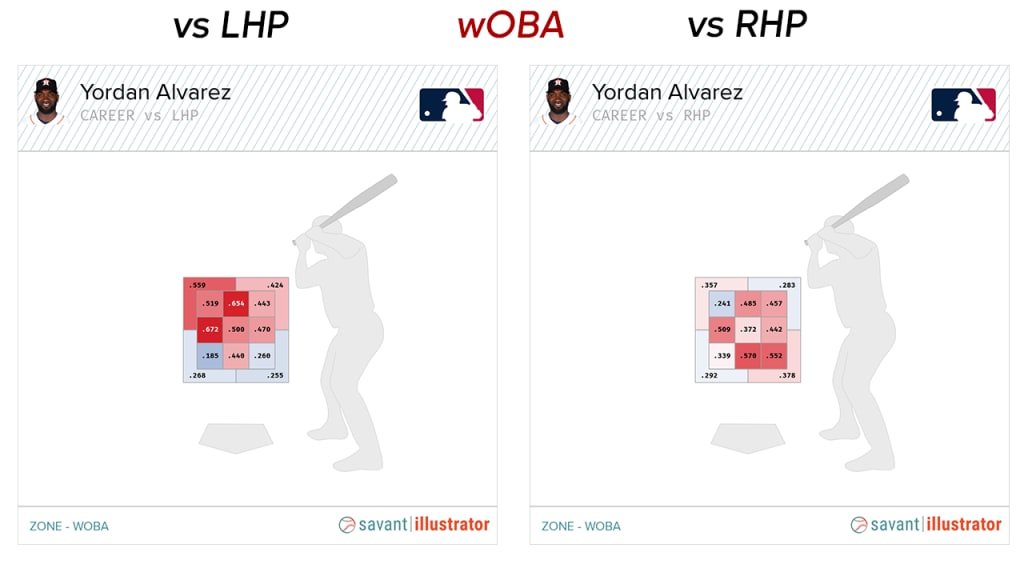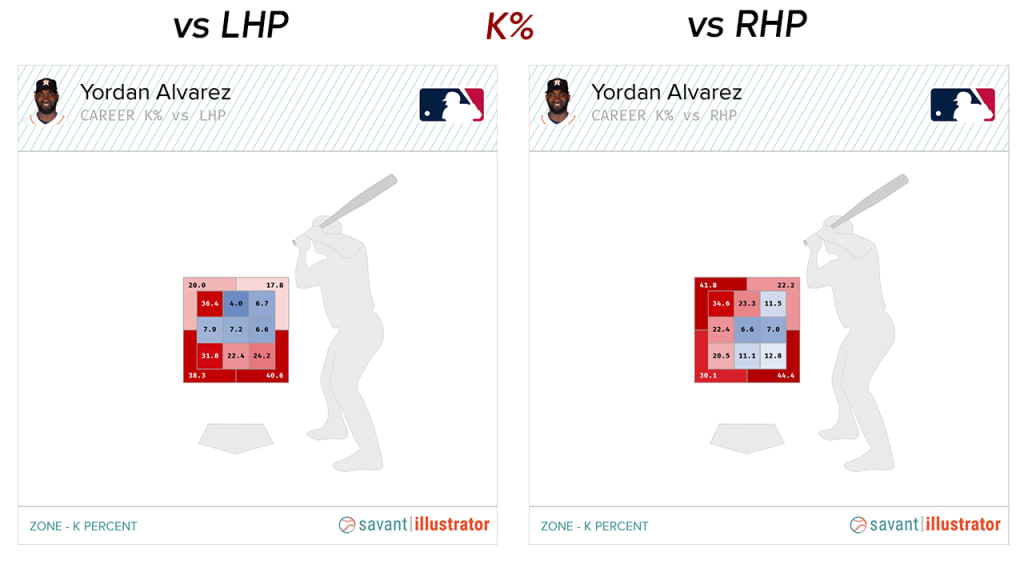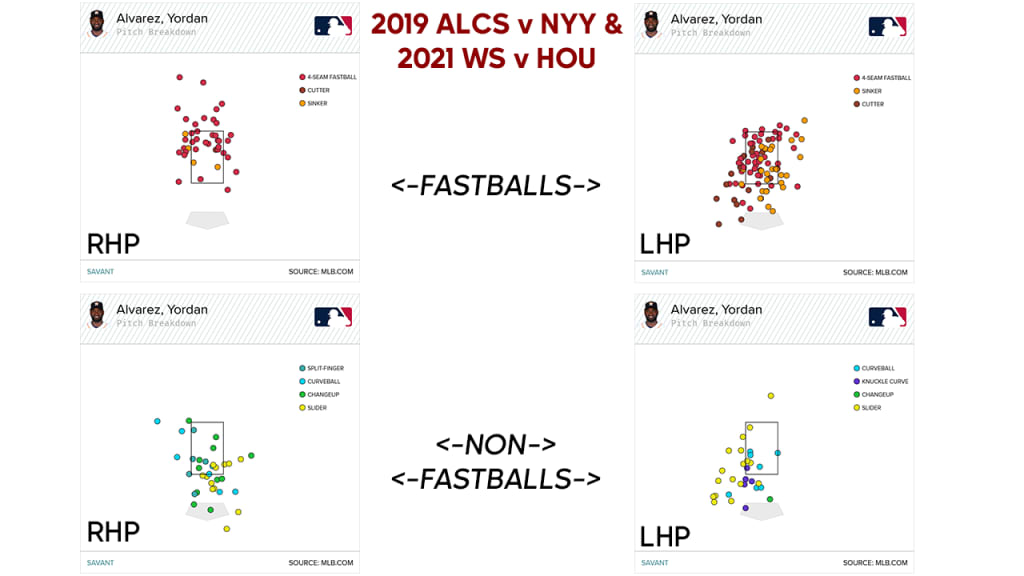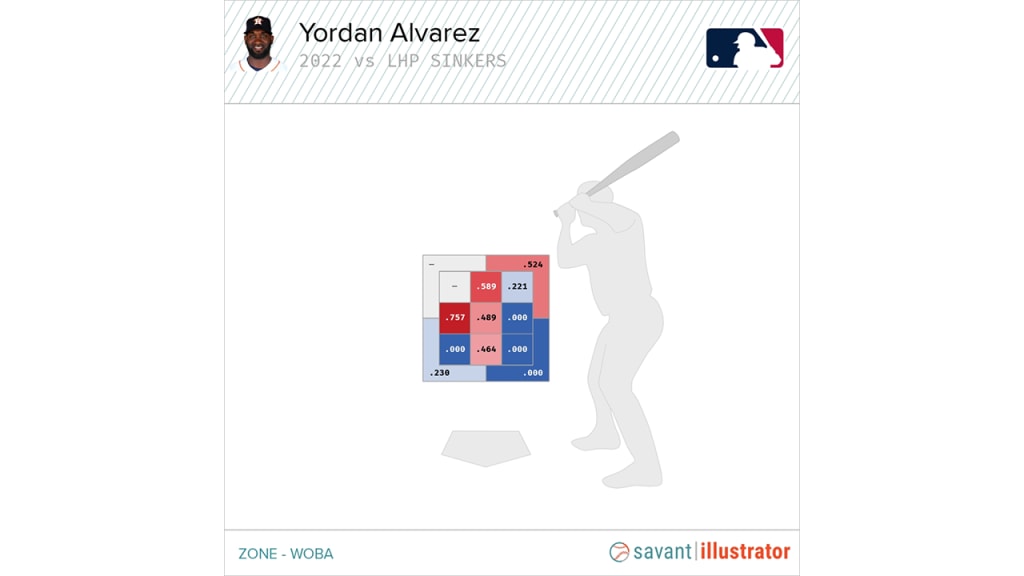How do you stop Yordan Alvarez? Far too often for pitchers, you don’t. Bring in a defending Cy Young winner in relief? Home run. Throw him 98 outside the zone? Home run. Wave him to first base intentionally? Now deal with Alex Bregman.
Alvarez homered in his first Major League game, and he’s basically never stopped. Only Aaron Judge out-hit him this year, and that’s underselling it to some extent; go back to integration in 1947, look at everyone who’s had at least 1,500 plate appearances through age 25, and realize that the list of best hitters goes: Frank Thomas, Mickey Mantle, Mike Trout, Albert Pujols and Yordan Alvarez. (Which, it should be noted, does not include Alvarez’s .872 postseason OPS.)
It’s not hard to argue that he’s the best hitter, or close to it, in baseball today. And yet: Teams do get him out. His career on-base percentage of .384 is excellent, but it also means that more 60% of the time he fails. Even the Mariners, when not otherwise allowing him to slug .733 against them, managed to get him out seven times in the 18-inning Game 3. It’s not like it can’t be done. It has been done.
There is, for example, last year’s World Series, when the Braves held him to a .100/.208/.200 line in 26 plate appearances. Or back in 2019 when the Yankees lost the ALCS, but held Alvarez to just .045/.125/.045 in 24 plate appearances.
It’s not easy, but it can be done. How? Allow us to present some dos and don'ts.
DON’T: Worry too much about the platoon advantage.
Alvarez is a lefty. Attack him with lefty pitching. Right? That was Seattle’s plan with Robbie Ray, anyway, and it didn’t work. But as Mariners manager Scott Servais explained, the goal wasn’t really to get a lefty pitcher on the mound. It was to get the right kind of pitch on the mound.
“Alvarez is very good left-on-left,” said Servais after Game 1. “We know that going into it. You have to weigh the odds and where it's at right there and, again, I'm looking at the numbers that are in front of me, I trust them. And what plays into that is not just the handedness of the pitcher, but what that hitter hits, what that pitcher fires out there. Now, you’ve got to get the ball [inside], you’ve got to execute, you’ve got to get the ball in the right spots.”
Ray did not get the ball in the right spot, catching too much of the plate.
But Servais’ point about the handedness of the pitcher being less of a factor is an important one. Just look at Alvarez’s platoon splits, or lack thereof.
2022
Vs. LHP: .998 OPS, 19% K
Vs. RHP: 1.030 OPS, 19% K
Career
Vs. LHP: .963 OPS, 22% K
Vs. RHP: .980 OPS, 23% K
Not a lot of difference, is there?
Going back to 2019, he’s got the 11th-best OPS against lefties, but all 10 names ahead of him are righties or switch-hitters. Why stop there, though? Go back to 1947. The best lefty-on-lefty hitter is Barry Bonds, unsurprisingly. The third-best is Stan Musial, ahead of Ted Williams. The second-best is Yordan Alvarez.
We’re obviously talking about only 557 plate appearances across parts of four seasons, and there can be noise in that. But as Servais noted, there’s not much that says getting the lefty pitcher out there adds a lot of value for you. Maybe that’s a relief for Houston's ALCS opponent, which is short on lefty relief pitching anyway.
DO: Throw high with righties and low with lefties.
If you have the right pitchers to do it, of course.
Alvarez having little platoon difference doesn't mean that there’s absolutely no difference between the pitcher handedness you use, of course. Against lefties, Alvarez is worse low than he is high. Against righties, it’s not quite as stark, but it’s also pretty clear that his hot zones are low.
It's not one-size-fits-all, and different pitchers have different strengths. But as a general starting point:

Another way to think about it is that he can’t do damage if he’s not making contact, and the strikeout version of those charts tell a similar story. The most strikeouts (red) are not the same against both hands, and the least strikeouts (blue) are where the pitcher might want to avoid.

He’s probably not going to miss in the middle or up-and-in against lefties, but you have a shot low. Against righties, there aren’t whiffs to be found low-and-inside. There might be some high, or outside.
In Game 1 of the ALCS, Seattle’s Andrés Muñoz (a righty) tried to go low-and-inside in the eighth inning He paid for it with a 113.7 mph rocket for a hit to right field; Alvarez would then come around on a Bregman home run, cutting Seattle’s four-run lead in half and setting the stage for the wild walk-off finish.
In Game 3, Muñoz got another shot. After a slider in the dirt, he threw three four-seamers (all at or near 100 mph) on the top end of the zone. This time, he got the strikeout.
DON’T: Worry that much about throwing him the same pitch twice in a row.
A thought that occurred to us, watching Alvarez pound Seattle pitching, was that maybe throwing him the same pitch twice in a row, letting him see it and time it up, was a bad idea. After all, Luis Castillo threw him a first-pitch sinker before allowing a home run on another sinker; Ray did the same exact thing. Then, in Game 3, Seattle attacked him with all sorts of approaches, and he was left without a hit. Is it as simple as that -- don't let him time you up with two similar pitches back to back?
Not exactly. First of all, we did just show you what Muñoz did with three consecutive four-seamers, but just to put this one to bed, we did the digging and came up with the numbers. In plate appearances that ended on at least two consecutive pitches of the same pitch type, Alvarez had a .431 wOBA, the fourth-best among those with at least 100 such plate appearances. (Aaron Judge, Freddie Freeman, and Juan Soto were better.)
But on plate appearances that did not end on consecutive pitches of the same type, Alvarez had a .415 wOBA, which is A) not that different and B) still second-best, this time behind Paul Goldschmidt. Maybe mixing it up is part of your pitcher’s game plan, and maybe it’s not. But it doesn’t seem to affect Alvarez, specifically.
DO: Learn from the past.
As we said: The Braves shut him down in the World Series last year. The Yankees did the same in the 2019 ALCS. In those two series, he hit .071/.220/.119 with a 36% strikeout rate.
Maybe it was just that even the greatest players can have a poor few games. Maybe it was that he was facing the best teams and the best pitchers. But also, maybe we can learn something.
Check out the images below. Look at the fastballs, on the top row. Righties went high, lefties went low -- which aligns with our impressions above.
Look at the breaking and offspeed, on the bottom row. Righties went low, without regard for side of plate. Lefties stayed almost uniformly away.

That's how Tyler Lyons got him to strike out in the ninth inning of Game 4 of the 2019 ALCS. It's how Will Smith ended last year's Game 4:
Or, perhaps, look at an individual pitcher who has had success against him. Toronto's Ross Stripling has emerged unscathed in six plate opportunities, and when you look at where he's pitched Alvarez, you see it's almost entirely outside, with nothing near that up-and-in danger zone for righty pitchers.
It is not, we should note, a foolproof plan, nor should every pitcher have the exact same plan, because Alvarez is just that good when he's right. But it does help having an approach, and trying to work within it.
DO: Identify the right combos of pitcher and pitch type.
Go back to what Servais said, about worrying more about the pitch and the spot than the handedness, and look at Alvarez’s 2022 heat map against lefty sinkers. There really was a zone to aim for, if Ray had managed to place it better.

Alvarez has actually never had a hit low-and-inside against a lefty sinker. Ever. (That is in large part, it must be stated, because it’s a spot lefty pitchers rarely ever throw to him.)
You can see that maybe that low lefty sinker works out, if you can do it right, and this is how teams game plan today. It's not just about lefty/righty. It's about swing paths and pitch shapes.
What else looks promising? Here are a few ideas, aside from the high righty fastball.
Curveballs, from righties. Alvarez has hit exactly one home run off a right-handed curveball in his career, striking out 41 times with a .311 OBP. Keep it outside.
Cutters from lefties. Alvarez doesn't see these all that often, but he's also slugged only .257 against them, too. Try up-and-in.
DO: Accept that good pitching doesn’t always beat good hitting.
“He's one of the best hitters in the world,” Bregman said during the ALDS. “That's the ultimate respect,” said manager Dusty Baker, referring to Seattle’s choice to intentionally walk Alvarez with a runner already on first. “I've seen that a bunch of times, but not in a long time since Barry Bonds.”
That's twice, now, that Alvarez has been mentioned in the same sentence as Bonds, going back to our lefty-on-lefty leaderboard above. When you're one of the best hitters in the world, as he clearly is, sometimes all the game planning in the world won't save you.
Look no further than the home run he hit off of Castillo in Game 2 of the ALDS. It was 98 mph. It was off the plate. There's absolutely nothing wrong with this pitch, other than where Alvarez deposited it.
As he told Eno Sarris of The Athletic earlier this year, he studies the data too, trying to see how pitches can get him out, so that he can make the proper adjustments. There's nothing in here that he and the Astros don't already know. That goes for the pitchers, too. It'll make for an amazing cat-and-mouse game.
